by Roger Blum
Sri Lanka
A tropical island paradise in the Indian Ocean
|
|
Sri Lanka, formerly called Ceylon under British imperial rule, is also known as the Pearl of the Indian Ocean. The island offers unique tropical fauna and flora amidst palm-fringed, gold-sand beaches, and is home to some stunning curiosities. The locals, often dressed in colourful sarongs and saris, retain a strong sense of their own culture. I was especially impressed by the friendliness and courteousness of the people that I met there, something that I experienced everywhere I went on the island. But the island’s inhabitants aside, I’d like to tell you about my two-week diving trip in Sri Lanka, during which I visited three particularly special diving centres: Unawatuna, Hikkaduwa and Beruwela.
|
The first dive of this trip was at Unawatuna Beach in the south west of the island. The beach, about 2 km south of the city of Galle, was once known as the most beautiful beach in Sri Lanka. Since earning this moniker, a variety of restaurants, shops and diving bases have settled here. I went diving here with the Ocean Dive Center. Even before arriving at the site, I saw about 10 blacktip reef sharks patrolling the knee-deep water in front of the dive center.
|
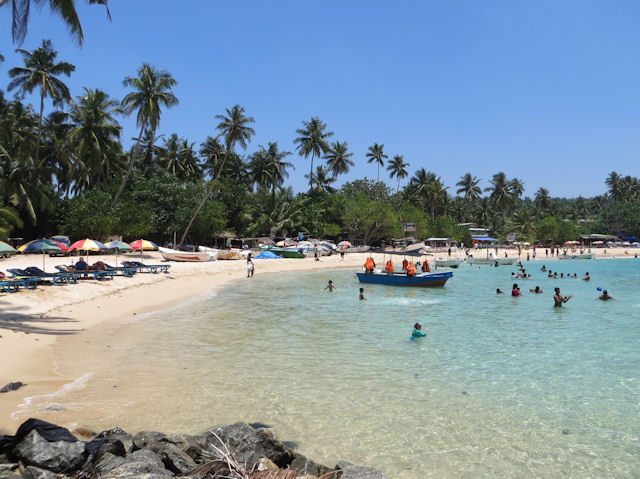
Unawatuna Beach
|
|
Once I got under water, I was a little bit surprised. I had been expecting a colourful coral garden á la Maldives, but I was met by a barren rocky landscape. The rocks are but sparsely covered with coral, with the scene reminiscent of the Mediterranean Sea - but with tropical fish. The reason for this slightly underwhelming sight is probably that Sri Lanka is not surrounded by a protective coral reef. This is also one of the reasons why Sri Lanka was hit particularly hard by the tsunami of December 2004. Ten years on, the effects of the deadly wave can still be clearly seen today.
|
|
Nevertheless, the underwater world is far from uninteresting. I dived at the Gala Pita Gala dive site. It is a big rock (Gala is Singhalese for rock), which rises from a depth of 25 m to a few meters below the water’s surface. Around it there are more big rocks and small gorges. The visibility ranges from 12 to 15 m; while I was diving, the water temperature was a pleasant 29° C.
|
|
Here, among many other species, I came across Blue ring angelfish (Pomacanthus annulatus), Orient sweetlips (Plectorhinchus orientalis), White-spotted pufferfish (Arothron hispidus), Valentini Puffer (Canthigaster valentini), Longfin bannerfish (Heniochus accuminathus), butterfly fish such as the
Indian Vagabond Butterflyfish (Chaetodon decussatus) as well as different kinds of doctor fish, of which the white-throated doctor fish (Acanthurus leucosternon) was the most remarkable. This particular specimen is recognisable by its blue body, yellow dorsal fin, black head, and its white chest and throat. For a short time, we were also joined by a small reef shark. The list is of course just a small sample of the fish I saw. It’s also worth mentioning that here you can also find beautiful nudibranchs molluscs on the rocks.
|
|
Other dive sites of Unawatuna include Wissa Gala (30 m), Aluth Gala (22 m), Napoleon Reef (16 m), Maha Kupatha (18 m), Diyamba Gala (12 m), Goda Gala (4 m).
|
|
Since the town of Unawatuna is only a few kilometres away from Galle, you shouldn’t miss the city’s famous fort, built by the Portuguese in the 16th century. It was later transformed by the Dutch and British colonial rulers into a large fortress. Today, you can visit the site for free.
|
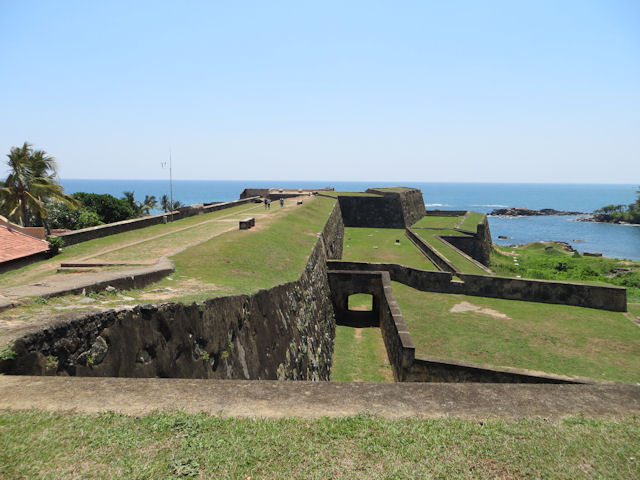 |
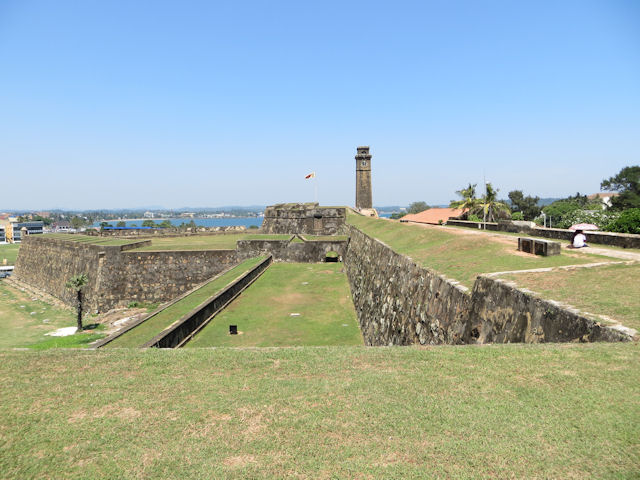 |
Galle was once Ceylon's largest port for passenger and cargo ships. It is therefore not surprising that there are many wrecks around the city. That includes the British steamship "Arcturus", the sailing steamship "Rangoon", the "Ethopy" and "Alliance", the Dutch ships "Dolfijn", "Avondster" and "Hercules" from the 17th century and an unknown wreck known as the "bottle wreck" because of its cargo. Galle’s strategic location, on the way to India and the Far East, made it an ideal transshipment port.
The "Tango Wreck" is also a popular dive site. The remnants of the ship are not far from Fort Galle in the southwest of the island. The wreck is on the itinerary of many dive centers, but little is known about the ship and how it came to sink. Firstly, it’s not completely clear which ship it is. Based on various nuggets of information, it is thought that the Tango is probably the remains of the SS Orestes. A British freight steamer loaded with bricks, the Orestes ran aground when it hit a reef here in 1875. Today the wreck lies at a maximum depth of 24 m.
|
|
You can head to the wrecks once you have made prior arrangements to do so during day trips from Unawatuna and Hikkaduawa.
|
|
Hikkaduwa is the diving center of Sri Lanka. The city is located about 100 km south of the capital of Colombo and 20 km north of Galle. Here you can find the Hikkaduwa Marine National Park, one of Sri Lanka’s two marine national parks. The first measures taken to conserve the area were taken way back in 1940. The area has been a national park since 2002. More than 170 fish species from 76 genera live here.
|
|
|
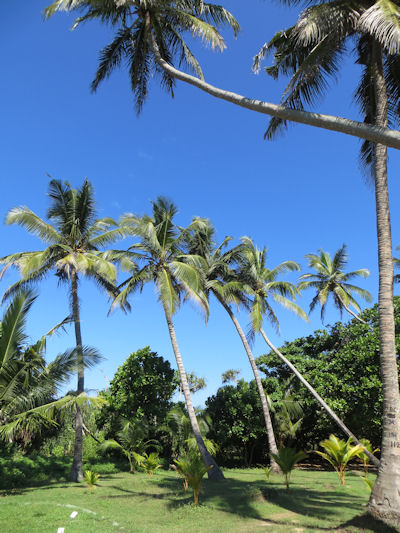 |
|
The underwater landscape is dominated by wild, rugged rocky landscapes. We drove to the dive site Thunatta Gala, a big rock that extends from 25 m deep to approximately six m under the water’s surface. Heading under water, I was greeted by a big Napoleon fish (Cheilinus undulatus), but he soon lost interest. In the open water, we could see jackfish out on the hunt. Some corals, sponges and algae were settled on the rock, perfect for typical tropical reef fish such as parrot, doctor, emperor, trigger, pennant and halter fish to graze amongst. On the sandy surface, dash-and-dot goatfish could be seen foraging with their prominent bartels for little snacks.
|
|
Blue ring angelfish (Pomacanthus annulatus), which are difficult to ignore due to their size and conspicuous patterning, are in abundance here. They have brownish-yellow bodies, with blue stripes extending in a ring-shaped motion from their heads’ over their whole bodies, all the way up to the dorsal fin. You mostly see these fish moving through the reef in pairs or happily allowing small bicolour cleanerfish (Labroides bicolor) to clean their scales. Besides the blue ring angelfish, I also came across a Koran angelfish in these waters. Their bodies, covered in blue stripes and dots, can grow up to 40 cm long.
|
|
The rock reefs of Hikkaduwa also have a lot to offer to lovers of the critters. Those who dive the reefs of Sri Lanka will likely encounter a multitude of colourful nudibranch molluscs. They are for the most part extremely poisonous and ward off potential predators with their striking body colouring. Due to their distinctive colourations they are popular subjects for photographs. Some are reminiscent of a fried egg in both shape and colour; others are more akin to the multi-tone costumes of harlequins. Also, because they move at the proverbial snail's pace, they are particularly easy to photograph.
|
Many nudibranchs have oval-shaped bodies with two retractable head sensors (rhinophores). The name Nudibranchia does not refer to the fact that these molluscs do not have a housing shell, but rather to their open gills, with Nudibranchia literally translating as “naked gills”.
Amongst the reefs of Sri Lanka you can also observe other stunning molluscs including chromodoris, wart slugs and aeolid nudibranchs. Attached is a small selection of photos of these beautiful critters.
|
|
If you take an even closer look, you can also discover the rare little dragonfish (Eurypegasus draconis) here. This animal has a conspicuous, elongated and tubular snout, as well as pectoral fins that can transform into wings.
|
|
During the dive, I sometimes felt a slight pinching or stinging sensation on my skin. This is due to contact with the small jellyfish n the water. The current carries so much plankton that the small jellyfish are not visible before it’s too late. The nettle poison is unpleasant, but harmless. After a few minutes it went away, until I once again crossed paths with yet another a small jellyfish...
|
|
For our second dive site, we went to Sunil Gala. This particular gala, as you might have guessed, is another big rock. The maximum diving depth here is 16 to 18 m. The current is a bit stronger here than it was at the Thunatta Gala. The visibility, at 8 to 10 m, is also a slightly poorer here. We constantly came across different grouper species here: the peacock grouper (Cephalopholis argus), discernable by its basic red colouring and light blue dots, as well as the blue striped grouper (Cephalopholis formosa) and the honeycomb grouper (Epinephelus merra), with its light brown, honeycomb-shaped spots.
At Sunil Gata I also saw several Pacific lionfish (Pterois antennata) and colourful butterfly fishhiding among elkhorn corals, shy Spotted trunkfish (Ostraction meleagris) and more small nudibranchs. Although they are usually very colourful, I had to look closely to find them on the rock.
|
|
Other dive sites of Hikkaduwa are Passi Gala, Silver Point, Kirla Gala (38 m), Theli Gala (26 m), Deba Gala (15 m), Black Coral Point (30 m), Cave (15 m), Hikkaduwa Diyaba Gala (21 m), Hikkaduwa Gala (18 m), Kadawara Gala (16 m), Kupatha, Dodanduwa Reef, Goda Gala (28 m) and Kete Gala (33 m). North of Hikkaduwa there is also the wreck "Conch" (21 m), the "Earl of Shaftesbury" (15 m) and "Norsa" (14 m). On full day tours, you can also dive the wrecks around Galle.
|
Diving centre:
Poseidon Diving Station
No. 304 Galle Road, Hikkaduwa
Tel.: +94(0) 91 2277 294
Email: info@divingsrilanka.com
www.divingsrilanka.com
(Stand: April 2014)
|
|
Another intriguing Sri Lanka diving centre is located between the two adjacent towns of Beruwela and Benota, the Ypsylon Dive Center. The resort is situated on a particularly idyllic section of beach, and from here guests are able to go on trips to 15 different dive sites.
|
|
With our trip set to start at 9.00am, we were expected to meet at 8.30 a.m. at the dive center. I had to travel to the site from the town of Ahungalla, but the half-hour morning trip aboard a Tuk-tuk was very entertaining.
|
|
Our first journey underwater was at the Hatteregalla dive site. It is a rocky area with a large plateau, gorges and overhangs. Gigantic boulders lie on the 22 m-deep seabed. In between these huge rocks there is an abundance of colorful tropical fish. The coral vegetation here is also sparse. The visibility at 8 m was much worse than in Unawatuna and Hikkaduwa. On top of this, the current was very strong, to such an extent that I had to let it take me over the natural path of the reef. However, such a strong current has the advantage of being home to much bigger fish. I met a large barracuda, a ray, big groupers and a napoleon fish. A giant triggerfish (Balistoides viridescens) guarded its clutch.
|
|
I made another dive at Madd Gala. It is not far away from Hatteregalla and has a similar underwater landscape: rocks, gorges and overhangs. Once again, the middling visibility and the strong current left a slight cloud over the dive. Nevertheless, I have fond memories of this particular dive site and this is largely thanks to the stars of Madd Gala, several huge Napoleon fish. Three of these giant wrasse with their distinctive humps showed up at a especially current-heavy area. At an estimate, they were between 1 m and 1.5 m in size. Adult Napoleon fish can grow to be over 2 m long and weigh up to 200 kg. Despite their size, these animals were difficult to get close to. Either they turned around just in time or swam by at a suitable distance. Because of the poor visibility I didn’t manage to take any decent pictures.
|
Diving centre:
Ypsylon Diving Beruwela, Sri Lanka
info@ypsylon.info
www.ypsylon.info
(Stand: April 2014)
|
|
Sea turtle station Kosgoda
|
Five of the world’s seven species of sea turtle live in Sri Lanka's waters: the Green Turtle (Chelonia mydas), the Leatherback Turtle (Dermochelys coriacea), the Hawksbill Turtle (Eretmochelys imbricata), the Loggerhead Turtle (Caretta caretta) and the Olive Ridley Turtle (Lepidochelys olivacea).
One of Sri Lanka's most popular coastal areas for these animals to lay their eggs is an area of Kosgoda beach in the southwest of the island. Several turtle farms have settled here. Here important work is carried out to protect the species. This is especially important because the turtle eggs are frequently poached due to their popularity among the natives for "medicinal" use. The turtle farms try to buy up the turtle eggs, and while this does not solve the problem of poaching, at least the eggs can hatch in the farms. Around the size of a table tennis ball, these eggs are buried in a sandy area and protected by fences and nets inside the grounds of the farms. Signs with the inscription "G.T.". (Green Turtle), "L.H." (Loggerhead), "H.B." (Hawksbill "Turtle"), "O.R." (Olive Ridley) and "L.T." (Loggerhead Turtle) indicate the location of the clutches alongside the remaining breeding period. After hatching, the young turtles are kept in pools for three days, giving them (and their shells)
time to grow stronger. This precaution is taken because the life of a young sea turtle is very dangerous. Even before leaving the beach, many fall pray to birds and monitor lizards, and once they get to the water there are already predatory fish lying in wait. Only one in 100 young turtles is expected to reach adulthood.
|
In addition to hatching and protecting the young animals, injured animals are also cared for in the turtle farms. There are several pools that contain turtles with separated limbs or other disabilities. One example was an Albino tortoise called "Heino". In the open sea, they would have little chance of survival.
So if you are interested in the underwater world of Sri Lanka, you should definitely visit a turtle farm in order to actively contribute to the protection of the species by paying a small entrance fee and making a donation. Besides, you can also learn a lot of interesting facts about these wonderful creatures that have for so long been an essential photo theme for us divers.
|
|
Conclusion: Sri Lanka is an absolute must see. You don’t have to go to this beautiful country exclusively to dive, but anyone who has the chance to get to know the unique underwater world of this island should do so. Even without all the colourful coral gardens, you can undertake fascinating dives at the rock reefs of Sri Lanka and you’ll likely come across some memorable surprises. The best time to visit is from December to March. From May to November it’s not possible to go diving and snorkelling in Hikkaduwa, Benota/Berulewa and Unawauna due to the high waves and dangerous currents.
|
|
|
Could be interesting for you:
|
|
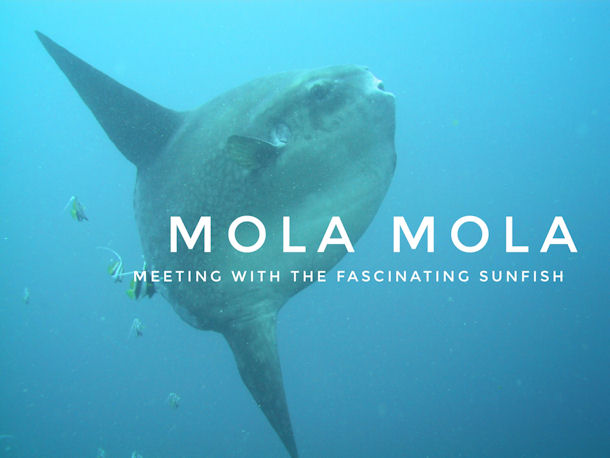
Meet The Gigantic Ocean Sunfish
"I recently saw a puffer fish." Nothing too special about that, some might think. "But this particular pufferfish was as tall as a small building." The usual reaction to this statement is wide-eyed disbelief. Or people think, maybe after inhaling too much nitrogen, that I’ve lost my mind... But this is a true story. In mid-November I went diving south of Bali on the island of Nusa Penida and met one of the most fascinating and mystical creatures on earth - the gigantic ocean sunfish.
[read more]
|
|
|
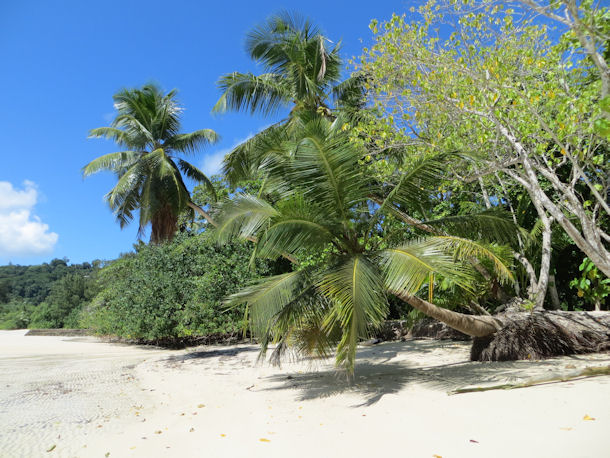
Diving tips for Seychelles
While the underwater world of Seychelles is considered one of the best diving areas in the world, the stunning beaches that line these granite and coral-cut islands are still relatively undiscovered and remain an under-the-radar destination for diving trips. A stunning abundance of fish adorns the colourful splendour of the Seychelles’ countless reefs: here, it’s possible to see sharks, rays and turtles almost every time you dive.
[more]
|
|
|
The opinions of other divers are both incredibly interesting and helpful to us. Through the experiences of other travellers, we have been able to uncover many useful tips and gain wonderful insight into other countries, as well as finding out about accommodation, the local community, and various activities, all in advance of arriving at our planned destination. Therefore, we would be very pleased to receive any other travel reports on the topic of diving & snorkelling in Sri Lanka, which we would gladly present here on our website. Simply contact us at info @ easydive24.de
|
|
|


